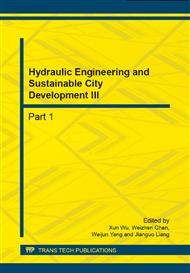p.246
p.251
p.255
p.261
p.267
p.271
p.275
p.279
p.283
Discussion of Muddy Surface Settling of Xiaolangdi Reservoir
Abstract:
Sediment settling velocity is an important parameter in particle suspension and indispensable link of hyperconcentrated flow as well as basic theory support for efficient sediment transport of Xiaolangdi Reservoir. This paper has adopted current sediment sample in Xiaolangdi Reservoir to take still water settling experiment, observed carefully silt sediment distribution during different settling duration under various initial concentrations, analyzed common settling velocity calculation method, and adopted settling duration curve method as calculation method to obtain a constant settling velocity of free settling section. Typical settling velocity that is obtained from experiments makes supplement and fitness to settling velocity formula of the existing groups of sediment sample, amends the formula coefficient, further explore the settling characteristics and settling velocity of fine particle mixed viscous sediment with water concentration change, and meanwhile this paper researched settling distance impact on settling velocity, existing sediment group settling transition to mesh settling critical transition silt concentration of Xiaolangdi Reservoir.
Info:
Periodical:
Pages:
267-270
Citation:
Online since:
September 2014
Authors:
Price:
Сopyright:
© 2014 Trans Tech Publications Ltd. All Rights Reserved
Share:
Citation:


